Archive:Labour market slack - unmet need for employment - quarterly statistics
Data extracted in January 2021
Planned article update: 27 April 2021
Highlights
The health crisis due to the COVID-19 has become in the European Union, like in other parts of the world, an economic crisis. As expected, the outcome of the economic storm started impacting the EU-27 labour market significantly in the course of the second quarter of 2020. More specifically, given the lock-down measures and the economic slowdown, some people may have lost their employment, have lost the opportunity to start a new job or to be renewed, or were obliged to work fewer hours than expected.
In addition, people who were previously considered as unemployed by fulfilling the ILO requirements of being available to work and searching for it, might have given up their search for a certain period of time due to poor economic prospects or the shutdown of enterprise activity, which consequently moves them outside the labour force.
The third quarter of 2020 is characterised by the reduction of the containment measures in many countries and the subsequent upturn of activity although to a different extent according to the countries and the sectors of activity. It is therefore assumed that beyond unemployment, more people either inside or outside the labour force may have and might have had an unmet need for employment. This whole potential demand for employment (the unemployed and the supplementary categories) constitutes the labour market slack. More precisely, the groups constituting the labour market slack (i.e. the unmet need of employment) are the unemployed people (according to the ILO definition), the underemployed part-time workers (those part-time workers who wish to work more), and people who might be associated to the labour force but who are not recorded as such because they do not fulfill one of the three ILO requirements of availability to work, searching for work and not being employed. This last group of people is called the potential additional labour force.
This article is based on quarterly and seasonally adjusted Labour Force Survey (LFS) data and investigates the impact of the COVID-19 crisis on the whole labour market slack; it also provides an overview of its specific components. Both the European and the country approaches are presented in this article, which shows the effect of the COVID-19 crisis at the global EU level and at the national level in the respective Member States as well as in three EFTA countries (Iceland, Norway and Switzerland), the United Kingdom and three candidate countries (North Macedonia, Serbia and Turkey).
This article is part of the online publication Labour market in the light of the COVID 19 pandemic - quarterly statistics alongside the articles Employment, Absences from work and Hours of work.
Note: this article uses the seasonally adjusted data from the third quarter of 2020, i.e. July-September 2020, which is compared in some sections to the last quarter of 2019.
Full article
Labour market slack in the EU-27
Labour market slack refers to the total sum of all unmet demands for employment and includes four groups: (1) the unemployed people according to the ILO definition, (2) the underemployed part-time workers (i.e. part-time workers who wish to work more), (3) people who are available to work but not searching for it and, (4) people who are searching for work but are not available for it. While the first two groups are in the labour force, the last two, also referred to as the potential additional labour force, are both outside the labour force. For this reason, the “extended labour force”, composed of both the labour force and the potential additional labour force, is used in this analysis.
The labour market slack is expressed as a percentage of this extended labour force, and the relative size of each component (each of the four groups) of the labour market slack can be compared by using the extended labour force as a denominator.
At EU level, people aged between 15 and 74 years old with an unmet need for employment accounted for 14.5 % of the extended labour force during the third quarter of 2020, as shown in Figure 1. The slack was more pronounced for women, who stood at 16.8 % of the extended labour force, than for men (12.4 %).
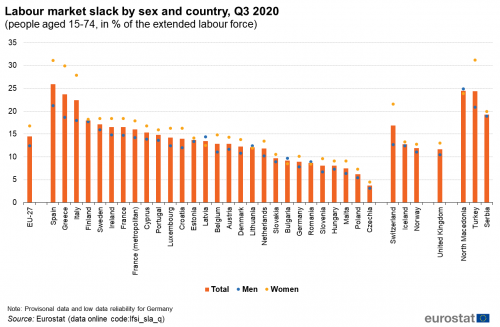
(people aged 15-74, in % of the extended labour force)
Source: Eurostat (lfsi_sla_q)
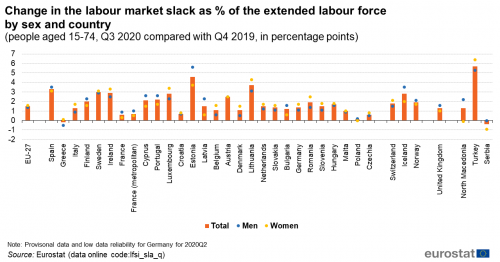
(people aged 15-74, Q3 2020 compared with Q4 2019, in percentage points)
Source: Eurostat (lfsi_sla_q)
Highest shares of people with unmet demand for employment in Spain, Greece and Italy, where it exceeds 20 % of the extended labour force
Among EU Member States, Spain (25.9 %), Greece (23.7 %) and Italy (22.4 %) recorded the highest slacks, reaching more than one fifth of the extended labour force (see Figure 2). Those countries also recorded the biggest gender gaps observed in the slack: 29.9 % for women against 18.7 % for men in Greece (gap of 11.2 percentage points (p.p.)), 31.1 % for women against 21.2 % for men in Spain and 27.9 % for women against 18.0 % for men in Italy (both countries with a gender gap of 9.9 p.p.). The labour market slack of women exceeded the men's slack in all EU Member States except in Latvia, Bulgaria, Romania and Lithuania, but with a gender gap in the slack lower than 2 p.p. in all these four countries.
The lowest labour market slacks in the EU-27 were observed in Malta, Poland and Czechia with less than 8 % of the extended labour force facing an unmet demand for employment, corresponding to respectively, 7.5 %, 6.2 % and 3.7 % of the extended labour force.
Evolution over time of the labour market slack
Increase in the labour market slack in all EU Member States, except in Greece with the biggest increases in Estonia, Lithuania, Spain and Sweden
The unmet demand for employment increased in the European Union from 13.0 % to 14.5 % between the last quarter of 2019 and the third quarter of 2020, reflecting the deterioration of the labour market due to the COVID-19 crisis. Since the first quarter of 2013, the slack grew for the first time between Q4 2019 and Q1 2020, by +0.4 p.p. It registered a consecutive and sharp increase of +1.2 p.p between Q1 2020 and Q2 2020, to slightly decrease between Q2 2020 and Q3 2020 (-0.1 p.p.) (see the dynamic tool at the top of the article).
The labour market slack also became more substantial between the last quarter of 2019 and the third quarter of 2020 in all EU countries, apart from Greece where it dropped by -0.2 p.p. (see Figure 2). Estonia, Lithuania, Spain and Sweden recorded the largest increases among Member States. In Estonia, the labour market slack rose from 9.1 % to 13.7 % of the extended labour force (+4.6 p.p.), in Lithuania from 8.4 % to 12.1 % (+3.7 p.p), in Spain from 22.6 % to 25.9 % (+3.3 p.p) and in Sweden from 14.1 % to 17.1 % (+3.0 p.p). Over the same period, only Poland reported an increase lower than +0.5 p.p. in the share of people addressing a potential demand of employment, with +0.1 p.p.
Biggest gender differences in the development of the slack in Estonia, Latvia, Lithuania, Luxembourg, Romania and Cyprus
At EU level, women registered between the last quarter of 2019 and the third quarter of 2020 a stronger increase in the slack than men (+1.6 p.p. for women and +1.4 p.p. for men) (see Figure 2). The biggest gender-based difference in the Member States was observed in Estonia: the labour market slack went up from 7.8 % to 13.4 % (+5.6 p.p.) for men and increased from 10.4 % to 14.1 % for women (+3.7 p.p.), which consists of an increase of the gender gap of +1.9 p.p. The same findings but to a lesser extent can be found in Latvia, Lithuania, Luxembourg, Romania and Cyprus, where the development of slacks of men and women differs by more than 1 p.p. between both quarters. The slack rose more for women than for men in 17 EU Member States while the evolution of the slack was more substantial for men than for women in 9 EU Member States. In one country, Austria, the development was equal for both men and women.
Higher labour market slack among young people
The EU labour market slack of young people, aged 15-24, stood for almost one third of the extended labour force in the third quarter of 2020 (31.3 %). It sharply exceeded those observed among the two other age categories, i.e. 25-54 and 55-74, standing for respectively 13.2 % and 11.6 % of the extended labour force in the EU (see Figure 3). In all Member States, the slack was also bigger among young people. The highest shares among people aged 15-24 in the third quarter of 2020 were observed in Spain (57.6 %), Italy (51.0 %), Sweden (48.9 %) and Greece (48.2 %), where around half of the young people of the extended labour force had an unmet demand for employment. In contrast, the slack concerned less than 20 % of the young people in the extended labour force in Hungary (19.6 %), Malta (18.7 %), Poland (17.3 %), Germany (17.1 %) and Czechia (11.0 %). The two age categories 25-54 and 55-74 recorded similar shares in the slack and showed smaller differences across countries.
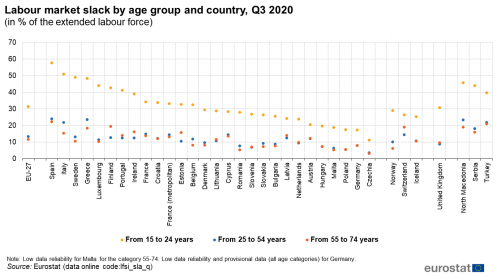
(in % of the extended labour force)
Source: Eurostat (lfsi_sla_q)
The development over time of the slack of young people is generally more pronounced than those of older people (see Figure 4). Regarding the health crisis, it is also clearly noticeable that the increase in the unmet demand for employment was also more substantial for young people in the first and second quarters of 2020 (+1.7 p.p. and +3.2 p.p.) than for people aged 25-54 (+0.3 p.p. and +1.2 p.p.) and people aged 55-74 (+0.4 p.p. and +0.5 p.p.). In the same way, the labour market slack of young people also decreased more prominently although to a lesser extent between the second and the third quarter of 2020 (-0.6 p.p.) compared with people aged 25-54 (-0.1 p.p.) and people aged 55-74 for which the slack remained stable.
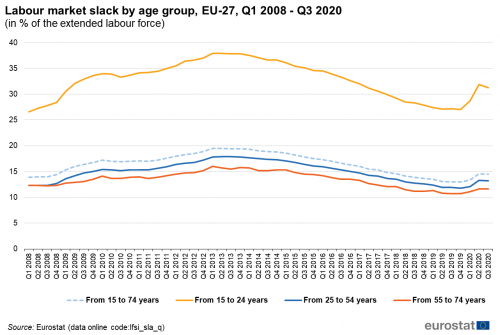
(in % of the extended labour force)
Source: Eurostat (lfsi_sla_q)
Composition of the labour market slack
Between Q2 2020 and Q3 2020, the relative stability of the slack resulted from a growth in unemployment offset by fewer persons available to work but not seeking
In the third quarter of 2020, in the EU-27, the slack accounted for 14.5 % of the extended labour force. Unemployed people stood for a bit less than half of the slack, with 7.1 % of the extended labour force. The remaining part of the slack referred to persons available but not seeking (3.6 %), underemployed part-time workers (2.9 %) and persons seeking work but not immediately available (0.8 %) (see Figure 5).
However, there were considerable developmental differences between each of the labour market slack components since the beginning of the COVID-19 health crisis. Indeed, the sharp increase recorded from the first to the second quarter of 2020 in the labour market slack (+1.2 p.p.) was mainly due to the increase in the share of people available to work but not seeking (+1.1 p.p.), rather than the increase in unemployment (+0.2 p.p.) or in the number of the underemployed part-time workers (+0.1 p.p.); persons seeking but not available decreased by -0.2 p.p. between the first and the second quarter. At that time, some people might have reconsidered their job search for a while due to the shutdown of many businesses or to parental responsibilities for taking care of children.
With the partial restart of activity that took place during the third quarter, the labour market slack decreased slightly (-0.1 p.p.). However, in the slack composition itself, there were major changes. Indeed, between the second and the third quarter, unemployment increased (+0.7 p.p.) and the share of people available to work but not seeking dropped (-0.9 p.p.) while the other components, i.e. the underemployed part-time workers and people seeking work but not immediately available, remained stable between both quarters. From this development, it can be deduced that, even if the total unmet need for employment did not vary much between the second and the third quarter of 2020, many people started searching for a job (again) during the third quarter.
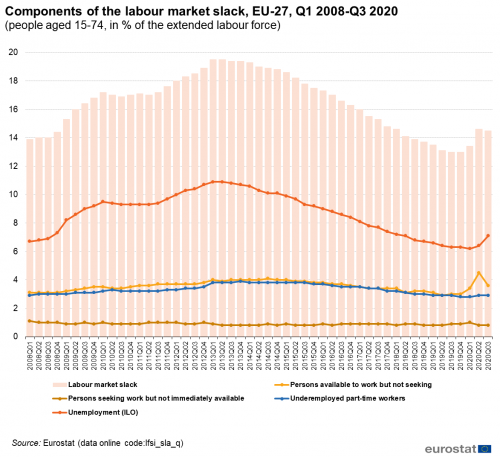
(people aged 15-74, in % of the extended labour force)
Source: Eurostat (lfsi_sla_q)
In the third quarter of 2020, the structure of the labour market slack was considerably different across EU countries (see Figure 6). In Germany, Ireland and the Netherlands, unemployment stood at less than 40 % of the total national slack, while the underemployed part-time workers and people in the additional labour force accounted together for more than 60 % of the slack. In contrast, unemployment accounted for more than 70 % of the total labour market slack in Lithuania, Czechia and Slovakia.
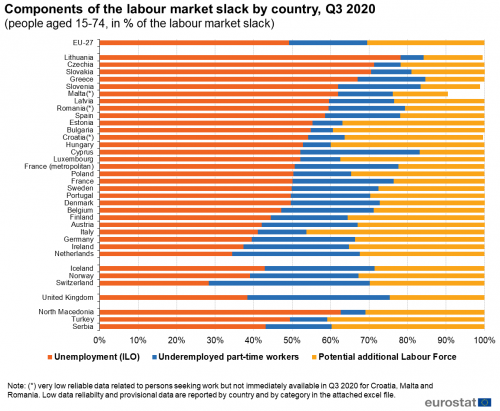
(people aged 15-74, in % of the labour market slack)
Source: Eurostat (lfsi_sla_q)
Specific consequences of the COVID-19 crisis on the labour market categories
This section focuses on the global picture of the labour market, looking simultaneously at the situation with respect to employment, the unmet demand for employment (i.e. the slack) and people who are neither employed, available to work nor seeking. This last category corresponds to people outside the extended labour force, and all three categories together refer to the whole population.
As aforementioned in this article, the economic winding down due to the COVID-19 pandemic has impacted the labour status of people unexpectedly compared with normal times, particularly as regards unemployment. At EU level, from the last quarter of 2019 to the second quarter of 2020, the economic slowdown led to a sharp decrease in employment: the share of employed people aged 15-74 (excluding underemployed part-time workers) decreased by -1.5 p.p. (from 58.3 % in Q4 2019 to 56.8 % in Q2 2020, computed in terms of percentage of the total population). This decrease was accompanied by an increase in people available to work but not seeking (+1.0 p.p.), which is a component of the slack, but also with an increase in the proportion of people outside the extended labour force, i.e. those who are neither employed, available to work nor seeking (+0.4 p.p.), while unemployment slightly rose (+0.1 p.p.) (see Figure 7).
From the second to the third quarter of 2020, the employment rate of people aged 15-74 (excluding underemployed part-time workers) went up by +0.3 p.p. (from 56.8 % in Q2 2020 to 57.1 % in Q3 2020, computed in terms of percentage of the total population). However, at the same time, unemployment increased by +0.4 p.p., while the number of people available to work but not seeking dropped by -0.6 p.p. The other categories changed marginally.
The situation at national level (see Figure 8 and Figure 9) shows different patterns according to the countries. Figure 8 provides for each country an overview of the population broken down by labour market categories in the third quarter of 2020. In addition, Figure 9 reports on the development of each category between Q4 2019 and Q3 2020. This last figure shows that the share of employed people (excluding underemployed part-time workers) decreased in all EU countries, except Greece, between Q4 2019 and Q3 2020, while the other categories fluctuated differently across countries, following or not the pattern observed for the EU as a whole.
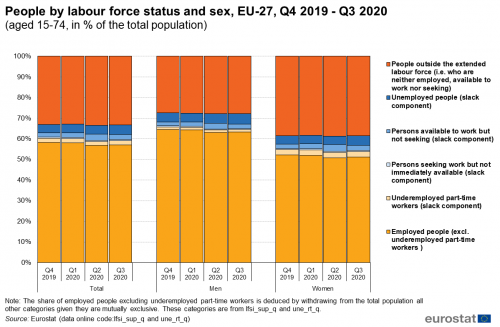
(aged 15-74, in % of the total population)
Source: Eurostat (lfsi_sup_q) and (une_rt_q)
For example, it is clearly visible that in some EU Member States, the decrease in the share of employed people went together with a rise in unemployment. This pattern was distinctly observed in Cyprus, Lithuania, Slovakia, Denmark, Croatia and Hungary. In addition, in Malta, Latvia, Belgium and Luxembourg, the increase recorded in unemployment seems to compensate the decrease in employment but also, the reported decrease in the number of people outside the extended labour force and/or the cut in the share of persons available to work but not seeking or even, in Malta, the decline in the number of underemployed part-time workers.
In the remaining countries, unemployment did not appear to be the "key" slack component. Developments in other components were more important. This is the case for the category of persons available to work but not seeking, which rose by more than 0.5 p.p. in parallel with a decrease in employment in Spain, Germany, Portugal, Ireland, Romania and Austria. Another pattern was moreover observed in Bulgaria, Slovenia, Italy, Poland, Czechia, Croatia and France (also France Metropolitan) where the number of people neither employed, available to work nor seeking (i.e. people outside the extended labour force) increased noticeably with respect to the decrease of employed people between the last quarter 2019 and the third quarter 2020.
Note: underemployed part-time workers and persons seeking work but not available are also included in Figure 9 but not commented on due to their lower weight in the total population.
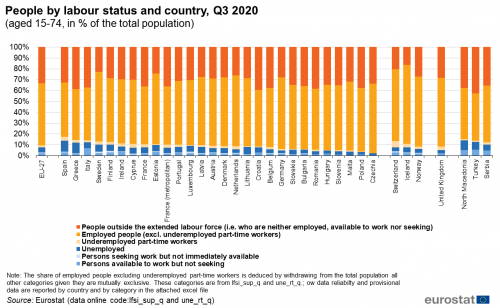
(aged 15-74, in % of the total population)
Source: Eurostat (lfsi_sup_q) and (une_rt_q)
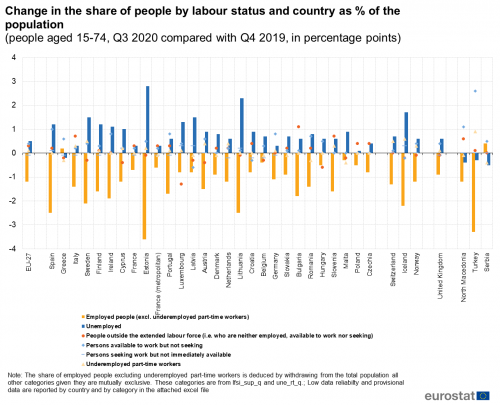
(people aged 15-74, Q3 2020 compared with Q4 2019, in percentage points)
Source: Eurostat (lfsi_sup_q) and (une_rt_q)
Focus on unemployment
Unemployment (ILO) is one component of the labour market slack. In the EU-27, it stood at 7.1 % of the extended labour force in the third quarter of 2020, specifically reaching 7.4 % for women and 6.9 % for men (see Figure 10).
In Greece and Spain, more than one in ten persons in the extended labour force was unemployed in the third quarter of 2020 (15.9 % and 15.2 % respectively). Moreover, Greece and Spain are among the countries for which the widest gap between men and women was found. Female unemployment in Greece accounted for 19.0 % and male unemployment for 13.4 % (difference of 5.6 p.p.). In Spain, unemployment stood at 16.6 % for women against 13.9 % for men (difference of 2.7 p.p.). Nevertheless, in the third quarter of 2020, the share of unemployed men in the extended labour force exceeded by 1.0 p.p. or more the share of unemployed women in Bulgaria, Lithuania, Finland and Latvia. In contrast, four EU Member States registered an unemployment rate of 4.0 % or less of the extended labour force: Czechia (2.7 %), Poland (3.1 %), Germany (3.5 %) and the Netherlands (4.0 %). Moreover, all these countries recorded a gender gap smaller than 0.7 p.p.
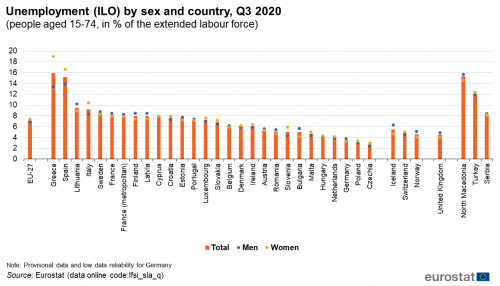
(people aged 15-74, in % of the extended labour force)
Source: Eurostat (lfsi_sla_q)
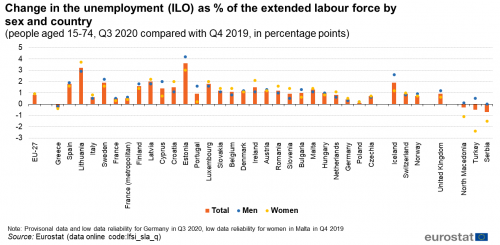
(people aged 15-74, Q3 2020 compared with Q4 2019, in percentage points)
Source: Eurostat (lfsi_sla_q)
Between the last quarter of 2019 and the third quarter of 2020, the unemployment rate increased by +0.8 p.p. (7.1 % in Q3 2020 against 6.3 % in Q4 2019) at EU level (see the dynamic tool choosing unemployment (ILO) and Figure 11). However, in Q3 2020, the share of unemployed people fluctuated by more than 1.0 p.p. in 16 EU countries. Estonia, Lithuania and Latvia, where the unemployment stood in the third quarter of 2020 at 7.6 %, 9.5 % and 8.0 % respectively, recorded the most substantial increases compared to the last quarter of 2019 (+3.6 p.p., +3.2 p.p. and +2.0 p.p.). In contrast, the share of unemployed people in the extended labour force decreased from the last quarter of 2019 to the third quarter of 2020, in Greece (-0.3 p.p.).
It may be useful to remember in this specific section on unemployment that in order to be considered unemployed according to the ILO's criteria, a person should be without work during the reference week, available to start working within the next two weeks (or has already found a job to start within the next three months) and have actively sought employment at some time during the last four weeks.
In the third quarter of 2020, as previously mentioned in this article, the lock-down measures were entirely or partially lifted allowing an upturn of business activities and public sectors (e.g. administration, schools or daycares) in many countries. This rebound in the activity might explain the change in the job search status of people i.e. people start (again) looking for a job or the change in their availability to work (e.g. people were available again to work because the children go to school). These are people that were actually not unemployed because they did not fulfill the criteria for integrated or reintegrated unemployment. So, in this exceptional situation, these changes in categories lead to an increase in unemployment together with a potential increase in employment.
Focus on the potential additional labour force
The share of the potential additional labour force in the extended labour force increased or was stable in all EU Member States, apart from Latvia and Denmark where it slightly decreased
As already mentioned, the potential additional labour force consists of two subgroups which are both outside the labour force, due to people's unavailability to work or lack of job search, but inside the extended labour force. One of these subgroups includes people who are available to work but do not seek it. At EU level, in the third quarter of 2020, this category accounted for 6.7 % of the population outside the labour force (see Figure 12). The other subgroup is related to persons who seek work but are not immediately available to start working; this last group stood at 1.4 % of the population outside the (not extended) labour force. In total, 8.1 % of the population outside the (not extended) labour force are actually connected to employment by expressing a certain willingness or demand for work. All countries, apart from Lithuania, follow the same main pattern clearly visible in Figure 12: people available to work but not seeking outnumber those seeking work but not immediately available.

(people aged 15-74, in % of the population outside the labour force)
Source: Eurostat (lfsi_sup_q)
The size of the potential additional labour force in proportion, this time, of the extended labour force is displayed in Figure 13. In Italy, in the third quarter of 2020, 10.4 % of people in the extended labour force were people available to work but not seeking or seeking but not immediately available. This was the highest share recorded among EU Member States for that quarter, and Italy was followed by Finland, Ireland, Spain, Luxembourg and Estonia that also recorded percentages higher than 5 % (respectively 6.4 %, 5.8 % and 5.6 %, 5.5 % and 5.2 %). In contrast, in Czechia, Slovenia, Lithuania and Slovakia, less than two percent of the extended labour force consisted of people who were available to work and not seeking and people who were seeking but not immediately available.
Note: due to low data reliability related to the category "people who are seeking but not immediately available", only persons available to work but not seeking are included in Figure 13 and 14 for Croatia, Malta and Romania.
Gender differences can be found at EU level. Indeed, the female potential additional labour force, as a percentage of the female extended labour force, stood at 5.2 %, and the male potential additional labour force, as a percentage of the male extended labour force, at 3.7 % in the third quarter of 2020.

(people aged 15-74, in % of the extended labour force)
Source: Eurostat (lfsi_sla_q)
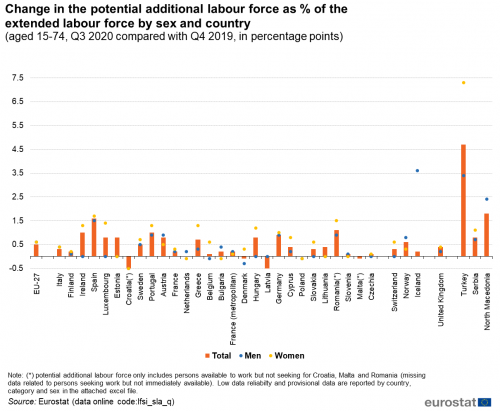
(aged 15-74, Q3 2020 compared with Q4 2019, in percentage points)
Source: Eurostat (lfsi_sla_q)
In four out of the 24 EU Member States for which data is available for both categories of the potential additional labour force, in the third quarter of 2020, the share of unemployed people in the extended labour force narrowly exceeded the share of the potential additional labour force (i.e. by less 1 p.p.): the Netherlands, Ireland, Germany and Poland. Italy was the only country in Q3 2020 where the share of the potential additional labour force (10.4 %) exceeded the share of unemployment (9.2 %) (see Figure 10 and Figure 13) .
Figure 14 shows that the potential additional labour force went up between the last quarter of 2019 and the third quarter of 2020 in the vast majority of the EU countries for which data is available. Indeed, the share of people seeking and not available together with those available but not seeking, as a percentage of the extended labour force, increased or was stable in all EU Member States, apart from Latvia and Denmark where it slightly decreased by -0.5 p.p. and -0.1 p.p. respectively. Between the last quarter of 2019 and the third quarter of 2020, the sharpest change for this category was observed in Spain (+1.6 p.p.), followed by Romania (+1.1 p.p. for people available but not seeking only), Ireland and Portugal (both +1.0 p.p.).
Focus on underemployed part-time workers
Highest shares of underemployed part-time workers in Spain, Cyprus, Ireland, France and Greece, very low shares in Czechia and Bulgaria
Inside the extended labour force, the highest shares of part-time workers wanting to work more were found in the third quarter of 2020 in Spain, Cyprus, Ireland, France (both France and France Metropolitan) and Greece (see Figure 15). In all these countries, 4 % or more of the extended labour force were underemployed part-time workers. More precisely, 5.0 % in Spain, 4.8 % in Cyprus, 4.5 % in Ireland, 4.3 % in both France and France Metropolitan and 4.2 % in Greece of people in the extended labour force had part-time jobs and wanted to work more hours. In contrast, 0.5 % or less of the extended labour force in Czechia and Bulgaria were underemployed part-time workers (0.3 % and 0.5 % respectively) making them a relatively small group within the extended labour force (see Figure 15).
At EU level, 2.9 % of the extended labour force were underemployed part-time workers. This share reached 4.2 % for the female population and 1.9 % for the male population.
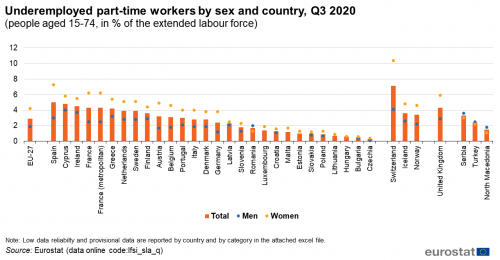
(people aged 15-74, in % of the extended labour force)
Source: Eurostat (lfsi_sla_q)
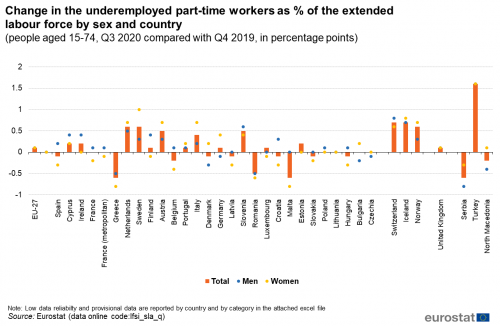
(people aged 15-74, Q3 2020 compared with Q4 2019, in percentage points)
Source: Eurostat (lfsi_sla_q)
Between the last quarter of 2019 and the third quarter of 2020, the share of underemployed part-time workers, as a percentage of the extended labour force, remained relatively stable (+0.1 p.p. at EU level) (see Figure 16). Only two countries recorded an increase exceeding +0.5 p.p. between both quarters, and three countries recorded a decrease exceeding -0.5 p.p. The two countries corresponding to such an increase are the Netherlands and Sweden, where the shares of underemployed part-time workers increased by +0.6 p.p. in both countries accounting for 3.9 % of the total extended labour force, also for both countries. In contrast, Malta, Greece and Romania reported lower shares of underemployed part-time workers in Q3 2020 compared with Q4 2019, with differences of 0.6 p.p. for Malta and Greece and 0.5 p.p. for Romania.
Source data for tables and graphs
Data sources
All figures in this article are based on seasonally adjusted quarterly results from the European Union Labour Force Survey (EU-LFS).
Source: The European Union labour force survey (EU-LFS) is the largest European household sample survey providing quarterly and annual results on labour participation of people aged 15 and over as well as on persons outside the labour force. It covers residents in private households. Conscripts in military or community service are not included in the results. The EU-LFS is based on the same target populations and uses the same definitions in all countries, which means that the results are comparable between countries.
European aggregates: EU refers to the sum of EU-27 Member States.
Country note: In Germany, from the first quarter of 2020 onwards, the Labour Force Survey (LFS) is part of a new system of integrated household surveys. Unfortunately, technical issues and the COVID-19 crisis has had a large impact on data collection processes, resulting in low response rates and a biased sample. For this reason, additional data from other integrated household surveys has been used in addition to the LFS subsample, to estimate a restricted set of indicators for the first three quarters of 2020, for the production of LFS Main Indicators. These estimates have been used for the publication of German results, but also in the calculation of EU and EA aggregates. By contrast, EU and EA aggregates published in the Detailed quarterly results (showing more and different breakdowns than the LFS Main Indicators) have been computed using only available data from the LFS subsample. As a consequence, small differences in the EU and EA aggregates in tables from both collections may be observed. For more information, see here.
Definitions: The concepts and definitions used in the Labour Force Survey follow the guidelines of the International Labour Organisation.
Five different articles on detailed technical and methodological information are linked from the overview page of the online publication EU Labour Force Survey.
Context
The COVID-19 pandemic hit Europe in January and February 2020, with the first cases confirmed in Spain, France and Italy. COVID-19 infections have now been diagnosed in all European Union (EU) Member States. To fight the pandemic, EU Member States have taken a wide variety of measures. From the second week of March, most countries closed retail shops apart from supermarkets, pharmacies and banks. Bars, restaurants and hotels have also been closed. In Italy and Spain, non-essential production was stopped and several countries imposed regional or even national lock-down measures which further stifled the economic activities in many areas. In addition, schools were closed, public events were cancelled and private gatherings (with numbers of persons varying from 2 to 50) were banned in most Member States.
The large majority of the prevention measures were taken during mid-March 2020 and most of the prevention measures and restrictions were kept for the whole of April and May 2020. The first quarter of 2020 is consequently the first quarter in which the labour market across the EU has been affected by COVID-19 measures taken by the Member States.
Employment and unemployment as defined by the ILO concept are, in this particular situation, not sufficient to describe the developments taking place in the labour market. In this first phase of the crisis, active measures to contain employment losses led to absences from work rather than dismissals, and individuals could not search for work or were not available due to the containment measures, thus not counting as unemployed.
The three indicators supplementing the unemployment rate presented in this article provide an enhanced and richer picture than the traditional labour status framework, which classifies people as employed, unemployed or outside the labour force, i.e. in only three categories. The indicators create ‘halos’ around unemployment. This concept is further analysed in a Statistics in Focus publication titled 'New measures of labour market attachment', which also explains the rationale of the indicators and provides additional insight as to how they should be interpreted. The supplementary indicators neither alter nor put in question the unemployment statistics standards used by Eurostat. Eurostat publishes unemployment statistics according to the ILO definition, the same definition as used by statistical offices all around the world. Eurostat continues publishing unemployment statistics using the ILO definition and they remain the benchmark and headline indicators.
Direct access to
- New measures of labour market attachment - Statistics in focus 57/2011
- European Union Labour force survey - selection of articles (Statistics Explained)
- LFS main indicators (lfsi)
- Unemployment - LFS adjusted series (une)
- Supplementary indicators to unemployment - annual data (lfsi_sup_a)
- Supplementary indicators to unemployment - quarterly data (lfsi_sup_q)
- Unemployment - LFS adjusted series (une)
- LFS series - Detailed annual survey results (lfsa)
- Total unemployment - LFS series (lfsa_unemp)
- Supplementary indicators to unemployment by sex and age (lfsa_sup_age)
- Supplementary indicators to unemployment by sex and educational attainment level (lfsa_sup_edu)
- Supplementary indicators to unemployment by sex and citizenship (lfsa_sup_nat)
- Total unemployment - LFS series (lfsa_unemp)
- LFS series - Detailed quarterly survey results (lfsq)
- Total unemployment - LFS series (lfsq_unemp)
- Supplementary indicators to unemployment by sex and age (lfsq_sup_age)
- Supplementary indicators to unemployment by sex and educational attainment level (lfsq_sup_edu)
- Total unemployment - LFS series (lfsq_unemp)